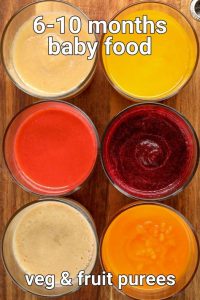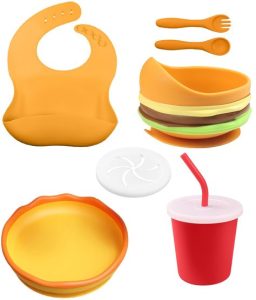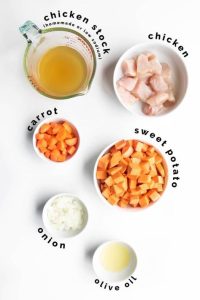Introducing your baby to solid foods is an exciting milestone! Vegetable purees are a great first food for babies because they are easy to digest and packed with nutrients. This article will explore the benefits of vegetable puree for baby, different vegetables to introduce to your baby, and tips for making and storing purees at home.
The Advantages of Vegetable Puree for Baby
There are many reasons to include vegetable purees in your baby’s diet. Here are some of the key benefits:
Packed with Nutrients:
Vegetables are a great source of vitamins, minerals, and fiber, which are all essential for your baby’s growth and development.
Easy to Digest:
Pureed vegetables are smooth and easy for babies to swallow and digest.
Exposure to New Flavors:
Introducing a variety of vegetables early on can help your baby develop a taste for healthy foods.
Promotes Self-Feeding:
Once your baby is old enough, purees can be a great way to encourage self-feeding.

Choosing the Right Vegetables for Your Baby
Not all vegetables are created equal when it comes to introducing them to your baby for the first time. Here are some factors to consider when selecting vegetables for purees:
- Sweetness: Babies tend to prefer sweet flavors. Sweet potatoes, carrots, and peas are all excellent choices for first purees.
- Mildness: Avoid vegetables with strong flavors or textures that might be overwhelming for a new eater.
- Low Allergenicity: Vegetables like broccoli, spinach, and peas are less likely to cause allergic reactions.
Remember: Always consult with your pediatrician before introducing any new foods to your baby, especially if they have a family history of allergies.

Creating Delicious and Nutritious Purees at Home
Making your own baby food purees is a great way to control exactly what goes into your baby’s food. Here’s a basic guide to get you started:
- Select your vegetables: Choose fresh, ripe vegetables and wash them thoroughly.
- Steaming or Boiling: Steaming or boiling are healthy cooking methods that preserve nutrients in the vegetables.
- Puréeing: Once the vegetables are cooked and soft, puree them in a blender or food processor until smooth.
- Consistency: The consistency of the puree should be thin enough for your baby to swallow easily. Add breast milk, formula, or water to adjust the thickness.
Tip: You can also freeze leftover purees in ice cube trays for easy portion control. Thawed puree cubes can be reheated gently in a saucepan or steamer.
Variety is Key! Introducing vegetable puree for baby
Once your baby has gotten the hang of a few basic vegetable purees, it’s time to expand their palate! Here are some tips for introducing new vegetables:
- Start with one vegetable at a time: This will help you identify any potential allergies.
- Offer new vegetables in combination with familiar favorites.
- Don’t give up! It may take a few tries for your baby to warm up to a new flavor.
Here are some additional vegetables you can introduce to your baby as they get older:
- Green beans
- Butternut squash
- Avocados (mashed, not pureed)
- Cauliflower
- Beets

The Joy of Sharing vegetable puree for baby
with Your Baby
Mealtime is a wonderful opportunity to bond with your baby. Here are some tips for making mealtimes enjoyable for both of you:
- Create a calm and relaxed atmosphere.
- Let your baby explore the food with their hands.
- Be patient and encouraging.
- Most importantly, have fun!
Introducing your baby to solid foods is a fun and rewarding experience. Vegetable purees are a great way to get started on this exciting journey. By following the tips in this article, you can create healthy and delicious purees that your baby will love.
Beyond the Purees: Exploring Textures
As your baby progresses through their solid food journey, you can start to introduce them to different textures. Here are some tips for helping your baby explore new textures safely:
- Mash instead of puree: Once your baby is comfortable with smooth purees, try mashing cooked vegetables instead. This will give them a thicker consistency to explore with their tongue and mouth.
- Offer finger foods: Gagging is a normal reflex as babies learn to swallow solid foods. When your baby is around 6 months old, you can offer them safe finger foods like steamed broccoli florets or ripe banana slices. These will help them develop their pincer grasp and practice gumming and manipulating food in their mouths.
Remember: Always supervise your baby closely when they are eating finger foods to prevent choking.
- Gradually increase chunkiness: As your baby gets used to thicker textures, you can gradually increase the chunkiness of their purees. This will help them transition to eating table foods eventually.

Safety First: Important Considerations for Vegetable Puree for Baby
While introducing your baby to new foods is exciting, safety is always the top priority. Here are some key safety tips to keep in mind:
- Honey: Honey can cause infant botulism, a serious illness. Do not give honey to babies under 1 year old.
- Choking hazards: Avoid hard, round foods or raw vegetables that could be choking hazards.
- Allergies: Introduce new foods one at a time to watch for allergic reactions. Signs of an allergic reaction can include hives, vomiting, or trouble breathing. If you notice any concerns, consult your pediatrician immediately.

Building a Healthy Relationship with Food
Mealtime is a great opportunity to lay the foundation for a healthy relationship with food for your baby. Here are some tips:
- Offer a variety of healthy foods: Expose your baby to a wide range of flavors and textures to encourage them to become adventurous eaters.
- Make mealtimes positive: Create a relaxed and enjoyable atmosphere during mealtimes. Avoid distractions like television and focus on the joy of sharing a meal together.
- Let your baby take the lead: Allow your baby to self-feed as much as possible. This will help them develop healthy eating habits and trust their body cues for hunger and fullness.
By introducing vegetable purees and gradually incorporating new textures and flavors, you can help your baby develop a love for healthy foods and set them on the path for a lifetime of healthy eating habits.
